![]()
![]()
![]()
Use LEFT and RIGHT arrow keys to navigate between flashcards;
Use UP and DOWN arrow keys to flip the card;
H to show hint;
A reads text to speech;
80 Cards in this Set
- Front
- Back
|
List the four major tissue types |

Epithelial tissue, Connective tissue, Muscle tissue, and Nervous tissue. |
|
|
Describe the functions of epithelial tissues. |
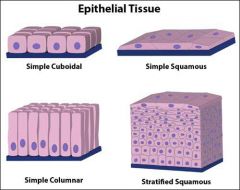
It is composed of sheets of cells that cover and line other tissues. For example, it lines bladder, mouth, blood vessels, thorax, and all of the body cavities and ducts in the body. |
|
|
What are the three major types of cellular junction found between epithelial cells? |
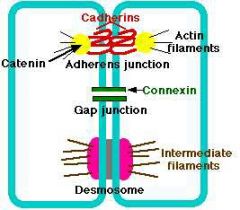
Tight junction, desmosome, and gap junction. |
|
|
Tight Junction |
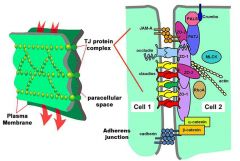
A type of intracellular connection that is impermeable to leaks. Passage of extracellular substances can occur only through the cell itself. Tight junctions are formed by the fusion of one cell's plasma membrane to another cell's plasma membrane. |
|
|
Desmosome |
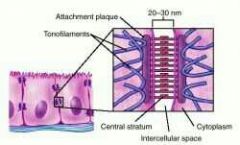
A type of intracellular attachment found in epithelial tissue. The bond is formed from the interlocking of filaments that connect the plasma membranes of adjacent cells. |
|
|
Gap Junction |

Proteinaceous pores that exist in the intestinal epithelial cells of most animals. These pores allow the passage of nutrients, as well as providing a channel for intercellular communication. |
|
|
Basement Membrane |
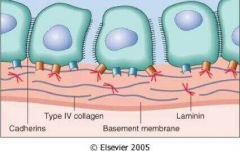
The foundation of the epithelial cell. It is a nonliving meshwork of fibers that cements the epithelial cell to the underlying connective tissue. It's strength and elasticity help prevent the cell from being torn off by intraluminal pressures, such as stretching or erosion caused by the rubbing of luminal material. It is manufactured and laid down by epithelial cells in varying degrees of thickness. |
|
|
List the different types of epithelial tissues |
Simple squamous epithelium, Simple cuboidal epithelium, Simple columnar epithelium, Stratified squamous epithelium, Stratified cuboidal epithelium, Stratified columnar epithelium, and pseudostratified columnar epithelium. |
|
|
Simple squamous epithelium |
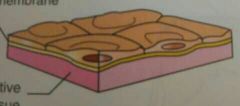
Delicate, single-layered, flat-celled epithelium found in the alveolar of the lungs and lining blood and lymph vessels. |
|
|
Simple cuboidal epithelium |
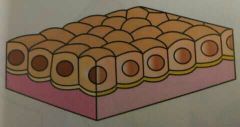
Composed of a single layer of cubic cells. Like simple squamous, they provide little protection from abrasion. Therefore it occurs in sheltered regions of the body where secretion and absorption take place. Found on the surface of ovaries, in the Secretary portions of glands, such as the thyroid, and in the lining of the ducts of the liver, pancreas, kidney, and salivary glands. |
|
|
Simple columnar epithelium |

Are elongated and closely packed together, making the epithelial relatively thick and more protective than the simple squamous and cuboidal epithelia. The nuclei are not centrally located, but aligned in a row at the base. They line the gastrointestinal tract, from the stomach to the rectum, and found in many Secretary ducts. |
|
|
Stratified squamous epithelium |
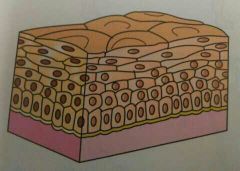
Consists of various cell layers. It occurs in regions of the body that are subject to mechanical and chemical stresses, such as the linings of the mouth, esophagus, vagina, and rectum. |
|
|
Stratified cuboidal epithelium |
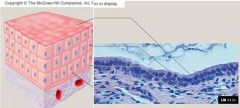
Generally occurs as two layers of cuboidal cells and is found primarily along large Secretary ducts, such as those of sweat glands, mammary glands, and salivary glands. |
|
|
Stratified columnar epithelium |

Rare and found only in select parts of the respiratory, digestive, and reproductive systems and along some Secretary ducts. |
|
|
Pseudostratified columnar epithelium |
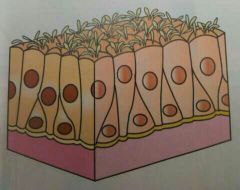
An epithelial layer that is not truly stratified. Most is ciliated and found in the respiratory tract and in portions of the male reproductive tract. |
|
|
Simple epithelia |
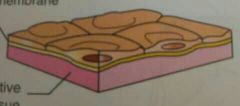
If there is only a single layer of epithelial cells, the tissue is classified as simple. |
|
|
Stratified epithelia |
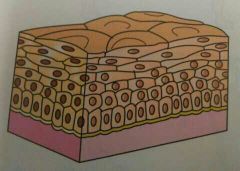
Thicker and stronger. More than one layer of cells. |
|
|
Cuboidal cells. |

Cube shaped cells with centrally located nuclei. |
|
|
Squamous cells |

Flat cells |
|
|
Columnar cells |

Tall, thin epithelial cells with nuclei located at the basal end; often ciliated. |
|
|
Gland |
A cell or group of cells that have the ability to manufacture and discharge a secretion. |
|
|
Excretion |
The elimination of waste materials from the cell or body. |
|
|
Secretion |
The process by which a cell or gland produces and expels some useful product; also used to refer to the product itself. |
|
|
Transitional epithelium |

Has the remarkable ability to stretch. It is found in regions of the body that are required to expand and contract as part of their normal function. This it is found in portions of the urinary tract, such as urinary bladder, ureters, urethra, and calyxes of the kidney. |
|
|
Endocrine glands |
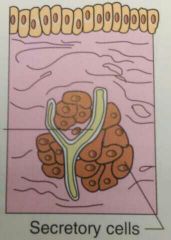
Glands that do not have ducts or tubules and whose secretions are distributed throughout the body. |
|
|
Exocrine glands |
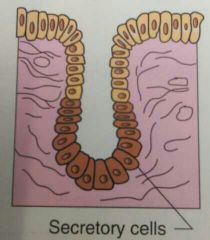
These possess ducts. More common than endocrine glands. They act by discharging secretions via their ducts directly into nearby areas where they may, for example, cover cell surfaces or empty into body cavities. Unlike endocrine glands, these secretions act locally and do not normally enter the circulation. |
|
|
Unicellular Exocrine gland |
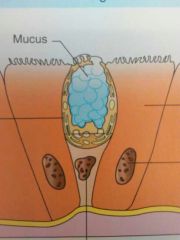
The only known example is the goblet cell. It is a doubtless Exocrine gland that secretes mucus. |
|
|
Multicellular Exocrine glands |
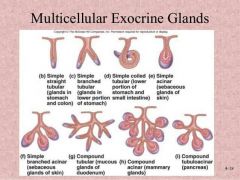
Made up of two distinct components: a Secretary unit in which secretions are produced by Secretory cells, and a duct that carries the secretion to the deposition site. |
|
|
Duct |
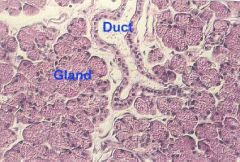
A tubelike channel that provides an exit route for secretory or excretory products. |
|
|
What are the three other classifications of cells? |
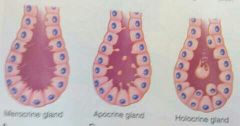
Merocrine, apocrine, and holocrine. |
|
|
Merocrine gland |

A gland who's secretions contain none of it's cells, this leaving the gland cells intact. Examples include salivary and sweat glands. |
|
|
Apocrine |

A gland whose secretions contain some of it's cellular material. Part of the Secretory cell is destroyed and must regenerate before the cell can secrete again. Examples of these are mammary glands, and some sweat glands. |
|
|
Holocrine glands |
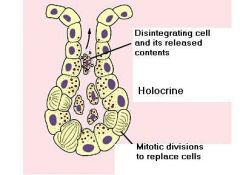
A gland whose glandular secretions contain not only the secretory product but also the cells themselves. Holocrine glands are destroyed in the process of secretion. The sebaceous gland is an example. |
|
|
Squamous cells |

Flat cells that make up squamous epithelial. |
|
|
Cuboidal cells |
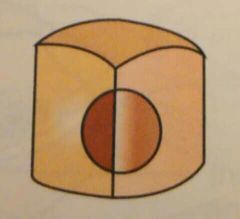
Cube-shaped cells with centrally located nuclei. |
|
|
Columnar cells |
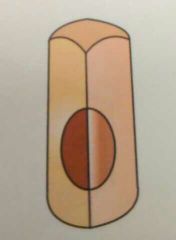
Tall, thin epithelial cells with nuclei located at the basal end; often ciliated. |
|
|
Simple Tubular gland |

Intestinal glands |
|
|
Simple Tubular coiled |
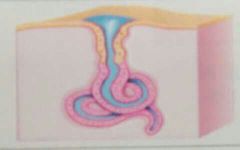
Sweat glands |
|
|
Simple branched Tubular |

Gastric (stomach) glands |
|
|
Simple alveolar |
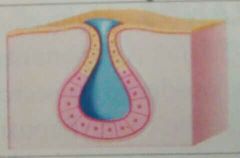
Sebaceous (skin oil) glands |
|
|
Simple branched alveolar |
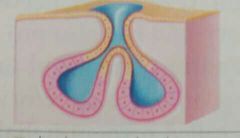
Sebaceous glands |
|
|
Compound tubular |
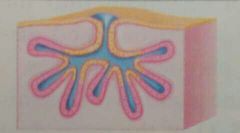
Mammary glands |
|
|
Compound alveolar |
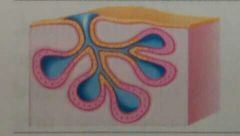
Mammary glands |
|
|
Compound tubuloalveolar |
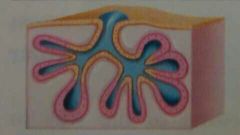
Salivary glands |
|
|
Mesothelium |
The epithelium that lines the pleural (chest), pericardial, (around the heart), and peritoneal (abdominal) cavities. |
|
|
Endothelium |
The epithelium that lines blood and lymphatic vessels. |
|
|
Ground substance |
In connective tissue. It is an amorphous, homogenous material that ranges in texture from a liquid or gel to a calcified solid. In soft connective tissues it is composed of unbranched chains of glycoproteins called glycosaminoglycans (GAGs). |
|
|
Connective tissue contains three types of fibers |
Collagenous, reticular, and elastic. |
|
|
Collagenous fibers |
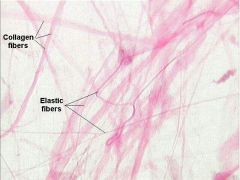
Strong thick strands composed of the structural protein collagen. |
|
|
Reticular fibers |
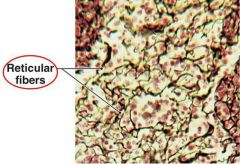
Like Collagenous fibers, are composed of collagen, but they are not thick. Instead, they are thin, delicate, and branched into complicated networks. |
|
|
Elastic fibers |
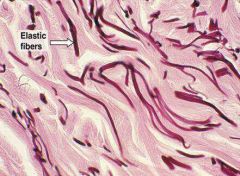
Composed primarily of the protein elastin. Like reticular fibers, they are branched and form complex networks, but they lack the tensile strength of Collagenous fibers. |
|
|
Fixed cells |
Cells that remain in the connective tissue. |
|
|
Transient cells |
Cells that pass in and out of the connective tissue. |
|
|
List types of fixed cells |
Fibroblasts, adipocytes, reticular cells. |
|
|
List types of wandering cells |
Leukocytes, mast cells, and macrophages. |
|
|
Diapedesis |
When cells squeeze through the walls of tiny blood vessels to enter the surrounding tissue. |
|
|
Mast cells |
Oval cells that are easily identified by the large number of dark-staining granules stored in the cytoplasm. |
|
|
Macrophages |
Massive, irregularly shaped phagocytizing scavengers that may be either fixed or transient in connective tissue. |
|
|
Connective Tissue Proper |
The largest classification and contains every subtype of connective tissue except bone, cartilage, and blood. |
|
|
List two subclasses of connective tissue proper |
Loose connective tissue, and dense connective tissue. |
|
|
Loose connective tissue includes |
Areolar, adipose, and reticular tissue. |
|
|
Dense connective tissue contains |
Dense regular, dense irregular, and elastic tissue. |
|
|
Areolar tissue |
A beautiful tangle of randomly placed fibers and cells suspended in a thick, translucent ground substance. |
|
|
Adipose tissue |
Commonly known as fat. It is Areolar tissue in which adipocytes or fat cells predominate. Found beneath the skin in spaces between muscles, behind the eyeballs, on the surface of the heart, surrounding the joints, in bone marrow, and in the omentum of the abdomen. |
|
|
White adipose tissue |
Found throughout the body, particularly in the deep layers of the skin. |
|
|
Brown adipose tissue |
Found in newborn animals and in animals that hibernate during the winter. |
|
|
Reticular connective tissue |
Composed of a complex, three-dimensional network of thin reticular fibers. |
|
|
Reticular connective tissue |
Composed of a complex, three-dimensional network of thin reticular fibers. |
|
|
Dense fibrous connective tissue |
Characterized by its densely packed arrangement of collagen fibers. |
|
|
Blood |
The red fluid that passes through vessels and that carries nutrient molecules and gases throughout the body and is the most atypical connective tissue. |
|
|
Bone |
Osseous connective tissue is the hardest and most rigid type of connective tissue. It's specialized matrix is a combination of organic collagen fibers and inorganic calcium salts, such as calcium phosphate and calcium carbonate. Bone, unlike cartilage, is well vascularized. |
|
|
Hyaline cartilage |
The most common type of cartilage found in the body. Composed of closely packed collagen fibers that make it tough but more flexible than bone. It is found as articular cartilage at the ends of long bones in joints and connects to the ribs in the sternum. |
|
|
Elastic cartilage |
Similar to Hyaline cartilage but contains a plethora of elastic fibers, which form dense, branching bundles that appear black microscopically. These fibers give elastic cartilage tremendous flexibility so that it can withstand repeated bending. |
|
|
Fibrocartilage |
Usually found merged with Hyaline cartilage and dense connective tissue. |
|
|
Haversion Canal |
Contains both a vascular and a nerve supply. |
|
|
Cartilage |
A tough, specialized connective tissue that is commonly called gristle. It is more rigid than dense connective tissue but is more flexible than bone. |
|
|
Mucous membranes |
Always found lining the organs that have connections to the outside environment. |
|
|
Serous membranes |
Called serosae. They line the walls and cover the ograns that fill closed body cavities, such as the chest cavity or thorax and the abdominal and pelvic cavities. |
|
|
Parietal layer |
The portion of the membrane that lines the cavity wall. |
|
|
Visceral layer |
The portion that covers the outer surfaces of the organs. |

